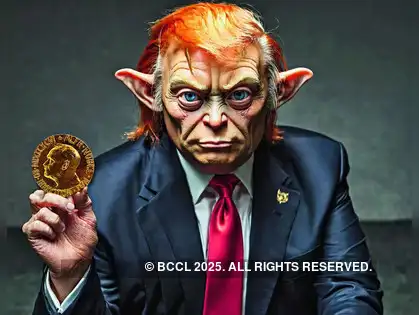India denied that Trump had anything to do with the India-Pakistan ceasefire, and this really pissed him off. To recover ground, India must nominate him for the Nobel – for bringing peace to Armenia and Azerbaijan.
What have we learnt in the last six months on how to deal with Donald Trump as he uses import tariffs as a weapon against one and all? We can count five clear lessons.
Taarif hi taarif! He loves flattery. He loved Pakistan for nominating him for the Nobel Peace Prize for supposedly ending India-Pakistan hostilities. This led him into visions of large oil discoveries off Pakistan’s coast, which not even Pakistanis had ever heard of.
India denied that Trump had anything to do with the India-Pakistan ceasefire, and this really pissed him off. To recover ground, India must nominate him for the Nobel – for bringing peace to Armenia and Azerbaijan.
Few Indians can find Armenia or Azerbaijan on a map. Fewer still know that mainland Azerbaijan on independence got an enclave called Nakhchivan on the other side of its neighbour Armenia. The latest peace agreement provides for a corridor to connect Azerbaijan and Nakhchivan, to be called the Trump Route for International Peace and Prosperity.
In addition, the two countries have resolved their 37-year dispute over Nagorno-Karabakh. Not earthshaking, you might say? Nevertheless, India must trumpet this as a great feat for which Trump deserves the Nobel Peace Prize. Do not let Pakistan do so before us. We cannot afford to miss out twice. Flattery is fundamental to good diplomacy.
That’s Enough, If You Would Please In his wide spectrum of tariffs on different countries, Trump has hit the poorest countries with highest tariffs, and rich ones with the lowest. This shows he is determined to use economic strength for maximising his tariff gains.
Poor Laos abolished all tariffs on imports from the US. Yet, Trump hit it with a huge 40% tariff, saying it was guilty of other unspecified trade barriers. The EU got away with a maximum 15% tariff on its exports and zero duty for US industrial goods entering Europe.
Trump threatened China with sky-high tariffs and drawing equally high retaliatory tariffs. China has been rewarded for its tough stance with two successive postponements on Trump’s tariffs while negotiations continue. This strengthens the case for India being tough, too, in the politest terms. It should say it will be obliged to impose retaliatory tariffs of 50% if the US does not accommodate India’s trade pleas. We must not surrender for no gain like Laos.
Realtariff as realpolitik Trump is using tariffs for foreign policy, not just ‘fair trading’ system. He has raised import tariffs on Brazilian products to 50%. This is largely because of a coup-plot case in Brazil’s Supreme Court against former right-wing president Jair Bolsonaro, whom Trump sees as an ally. Brazil has retaliated with 50% tariffs of its own.
Trump’s threat to penalise India for buying Russian oil is again an attack on India’s foreign policy. India is determined to have good relations with Russia – it is its main supplier of cheap arms and a reliable ally on most issues in UNSC – even as it avows friendship with the US. India must stand firm.
Another example of Trump’s tariffication of foreign policy is his threat to impose 36% tariffs on Thailand and Cambodia if they do not halt their recent border war. If the fighting really stops, that will be another opportunity for India to lionise Trump and nominate him yet again for the Nobel Peace Prize.
For a fistful of dollars Trump is using tariffs to garner revenue to control burgeoning fiscal deficit. Let nobody think he merely wants some sort of trade fairness. He says faster growth through his ‘beautiful’ tax cuts will yield enough revenue to avoid a ballooning public debt. But he knows this is not enough, and seeks to get up to $300 bn through import tariffs. If this works, expect him to increase the dose.
From Biden’s time, the US had stopped export of high-end chips to China on the grounds of national security. But Trump has just agreed to let Nvidia and AMD export these very chips to China, provided they give 15% of their Chinese revenue as a fee to the US government. This is an unexpected – indeed, astonishing – sale of US national security for some tax revenue.
That shows how important he views the raising of revenue through tariffs. Lesson: India must be prepared for repeated tariff threats in the rest of Trump’s term.
Keep offshores on our shores Expect future Trump assaults on India on the offshoring of US jobs to GCCs in India. Nasscom estimates that India has 1,700 GCCs employing 1.9 mn people. These are critical for India’s future. It must stand firm on GCCs, too.
Overall conclusion: India must prepare for repeated attacks by Trump for varied reasons in the next four-odd years. In dealing with them, we need something we can give up in return for the US giving up its demands. We cannot give up farm import barriers for political reasons. Or Russian oil for economic and foreign policy reasons.
Retaliatory tariffs – or the threat of imposing them – are what we can threaten, and then give up. Stay tough.
This article was originally published by The Economic Times on Apr 23, 2025.


